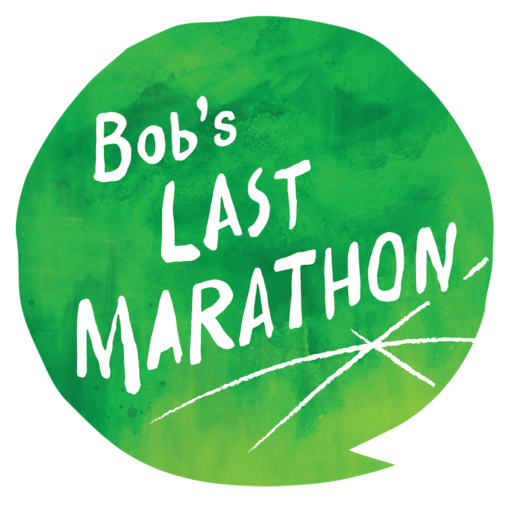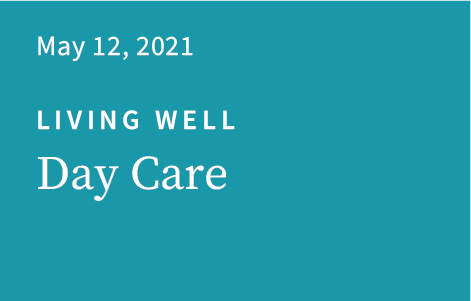Transcript
Day Care
About a year after his diagnosis, Bob and I started casually talking about day care. The idea was planted in my mind by our care manager, Stephne, who had started preparing us for the time at some point in the future when Bob might benefit from spending part of the day socializing with other people and engaging in structured activities. The idea hovered vaguely in the back of our minds for a few months. We even had brochures from two nearby day care centers. But we were put off by the photos of attendees, stereotypical dementia patients with untidy gray hair and a distant gaze. They didn’t seem to be enjoying themselves. Bob and I agreed—“Maybe not now.”
But one morning, “now” arrived.
For a good part of that year, Bob and I had a nice routine, mostly keeping to our own separate schedules. I would be out the door at 5:30 am for a workout, and Bob would get his breakfast, read the paper, and maybe take a run.
But on this Wednesday morning, Bob didn’t greet me with his usual “How was your workout?” Instead he just sat on the couch, looking lost.
Over the next few days my feelings cycled from surprised, to worried, to nearly upset with him. I realized that this was a turning point. This couldn’t go on. My emotions got away from me as I said, “Look at you. You look lost. I can’t sit around all day to keep you company, keep you entertained.” Bob responded quietly, in his good-natured way, “Okay. I’ll go to the day care center,” and named one of the two we’d talked about.
That was Bob through and through. Always conciliatory, agreeable, and tuned in to my feelings. He knew I was upset, and seemed to recognize he was getting on my nerves. He suggested the solution before I could.
Both facilities came highly recommended, and both were within five miles of our home. I scheduled visits and, in each case, we were received by the director, who gave us a tour, introduced us to the staff, and showed us typical daily schedules, lunch menus, activities, etc. Both made it clear that our meeting was a two-way interview. In other words, that it was our mutual goal to find a good fit, knowing that a day care decision could be a long-term one: It was a place where our loved ones would spend progressively more days, possibly for a number of years. All parties had to feel comfortable.
Even though the two centers looked perfectly fine, in the end, there were several deciding factors. While both were located in quiet residential neighborhoods, the one we chose had beautiful, expansive grounds that suited Bob’s love for the outdoors. I also liked that the director, Florence, was a social worker by training, whereas the other director was a business executive, relatively new to day care and people with dementia. It was clear that Florence understood the essence of people with dementia and their family caregivers. She expressed as much concern for my well-being as she did Bob’s. Which resonated later when I learned that Florence’s own mother suffered from Alzheimer’s disease. As she explained the fee structure to me, Florence emphasized, several times, that if I should ever have difficulty paying the monthly fee, she would help me look for assistance. Her compassion touched me.
Florence was also wise—and firm. When we discussed transportation, I mentioned that Bob was still driving, and in fact had driven to our appointment that day. Florence made it clear that no one attending the day care center drove on their own, and gave me some transportation referrals. What also clinched the decision for me was Kate, the nurse/case manager who had recently completed a research project at the center and knew them well. She gave the center high marks, then jumped through hoops to pull Bob’s enrollment paperwork together in a matter of days.
Throughout the process, Bob was cooperative as always, and entrusted me with the decisions. We began with a two-day program. Later, we moved to a three-day arrangement, and eventually five days a week, as Bob needed more help not only with keeping himself engaged with reading, puzzles or art, and staying alert, but also with daily routines such as getting lunch.
I still remember Bob’s first day. When Bob’s driver brought him home, I realized I’d had almost six hours of uninterrupted time to myself—something I had not experienced for some time. I got work done, was energized by the quiet time, and was able to engage with Bob more enthusiastically than ever, talking with him, asking about his day, and making plans for the rest of the day.
Over the years, it was clear that Bob enormously enjoyed his time at the day care center—chatting with people, watching people, and participating in current events discussions, exercise, art, and music. He especially enjoyed music—singing in groups, banging on drums, or just clapping along.
He also liked art, and I was the beneficiary of many of his art projects—cards on Valentine’s Day and major holidays, and a soft pillow with a sticky note on it—To Lena. Love Bob—that I still keep in front of me in our family room.
Bob loved the food and the many treats he couldn’t get at home—hearty sandwiches, french fries, and, oh, the ice cream socials that were a weekly treat. Yes, he was happy with his day care, but his enjoyment never overshadowed his appreciation for me. Whenever I arrived early to pick him up for a special outing or appointment, I would see him walking gleefully down the hallway toward me, escorted by a staff member, repeating excitedly, “Lena’s here? Lena’s here?”
Bob’s physical and cognitive health were monitored by the attentive staff. Once in a while, a staff member would fact-check Bob’s storytelling with me: “Did you really take him to see the solar eclipse?” Of course I did! It felt good to know they were engaging with Bob.
I would get an occasional call from the nurse, to tell me that Bob had a runny nose and ask if I could keep him home for a day or so. Or she might call to ask me if Bob had gotten his flu shot. Or it might be a reminder for me to send in updated health records as requested. I also appreciated the periodic phone calls from the director of the center to tell me how Bob was doing.
Over the years, I’ve also had occasion to recommend day care to friends or fellow support group members. I’d praise the benefits of social stimulation and a variety of activities, from guided conversations and art projects to music and exercise—a rich program that is hard to duplicate at home. And for the family caregiver, it’s our respite time. Time we can count on to devote to ourselves, whether for work or pleasure, allowing us to resurface more energized to engage with our loved one.
Lena Chow Kuhar

